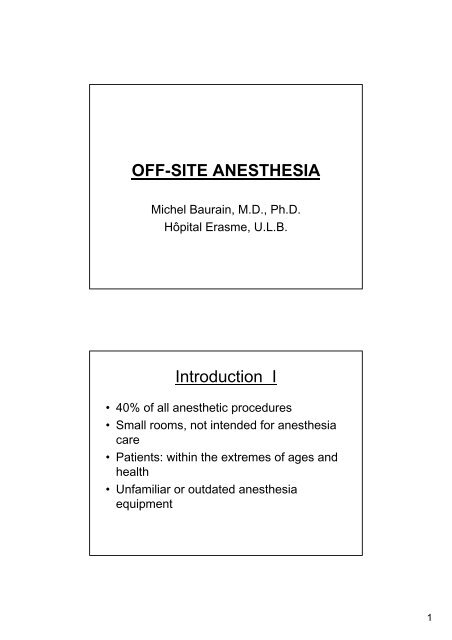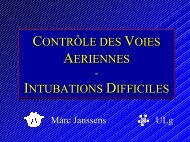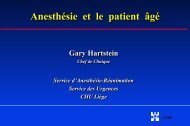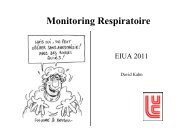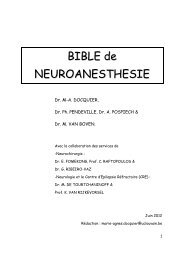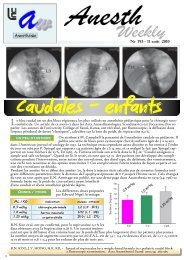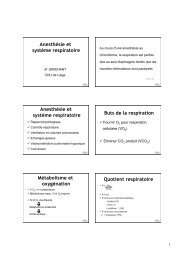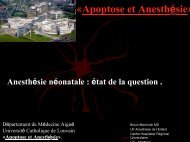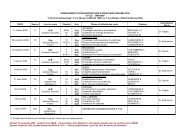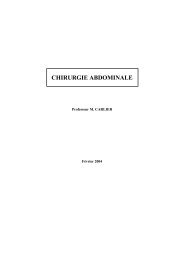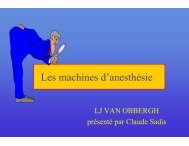OFF-SITE ANESTHESIA Introduction I - virtanes
OFF-SITE ANESTHESIA Introduction I - virtanes
OFF-SITE ANESTHESIA Introduction I - virtanes
You also want an ePaper? Increase the reach of your titles
YUMPU automatically turns print PDFs into web optimized ePapers that Google loves.
<strong>OFF</strong>-<strong>SITE</strong> <strong>ANESTHESIA</strong><br />
Michel Baurain, M.D., Ph.D.<br />
Hôpital Erasme, U.L.B.<br />
<strong>Introduction</strong> I<br />
• 40% of all anesthetic procedures<br />
• Small rooms, not intended for anesthesia<br />
care<br />
• Patients: within the extremes of ages and<br />
health<br />
• Unfamiliar or outdated anesthesia<br />
equipment<br />
1
<strong>Introduction</strong> II<br />
• Unfamiliar to the anesthetic implications of<br />
these procedures<br />
• To work with personnel who are less (or<br />
no) familiar with the anesthetic aspects of<br />
patients care in these settings<br />
• Remoteness from available help<br />
• Rapid transfer to an operating room for<br />
surgical procedure<br />
Common Procedures I<br />
Imaging Procedures:<br />
Computed tomography<br />
Interventional radiology (vascular & others)<br />
Functional brain imaging<br />
Interventional neuroradiology<br />
Magnetic resonance imaging<br />
Ultrasound-guided diagnostic and therapeutic<br />
procedures<br />
Radiotherapy procedures:<br />
Teletherapy, brachytherapy<br />
Intraoperative radiotherapy, radiosurgery<br />
Psychiatric procedures:<br />
Electroconvulsive therapy<br />
2
Common Procedures II<br />
Urology:<br />
Extracorporeal shock, wave lithotripsy<br />
Cystoscopy procedures (bladder, prostate)<br />
Cardiology:<br />
Cardiac catheterization, cardioversion<br />
IAC & foramen ovale closing<br />
Gastroenterology:<br />
Upper endoscopy, colonoscopy<br />
Liver biopsy, TIPS<br />
Interventional procedures (cholangiography…..)<br />
Gynecology:<br />
In vitro fertilizations<br />
Common Procedures III<br />
Pneumology:<br />
Rigid bronchoscopy, interventional procedures (bronchialtracheal<br />
prosthesis), laser therapy<br />
Ophtalmology:<br />
Retinoscopy, tonometry, electro-retinography, selective<br />
eyes surgery<br />
Dental procedures<br />
Neurophysiology<br />
Brainstem auditory evoked response<br />
Emergency room procedures:<br />
Emergency endotracheal intubation, central venous line<br />
insertion, orthopedic manipulations<br />
3
Common procedures in Children<br />
1. Diagnostic radiology:<br />
CT, MRI, Bone Scan<br />
2. Cardiovascular interventions:<br />
angiography, cardiac catheterizations,<br />
3. Therapeutic radiation<br />
4. Diagnostic & interventional procedures:<br />
bronchoscopy, eye examination, endoscopy,<br />
ultrasound, transesophageal echo,…<br />
5. Diagnostics exams:<br />
lumbar puncture, bone marrow aspiration,<br />
biopsy, evoked potentials<br />
6. Painful procedures:<br />
IV cannulation, dressing change, urodynamic study, minor<br />
surgery in emergency department<br />
Radiocontrast Media Use I<br />
1. Caution:<br />
Preexisting renal insufficiency<br />
Diabetes mellitus<br />
2. Contrast-induced nephrotoxicity:<br />
Most reliable defenses:<br />
1. Adequate hydration<br />
2. Stable hemodynamics<br />
3. Furosemide, mannitol, dopamine,<br />
acetylcysteine, fenoldapam <br />
3. Mechanisms:<br />
1. Direct chemical toxicity<br />
2. Effects of hypertonocity on red blood cells<br />
hypoperfusion on end organs<br />
4
Radiocontrast Media Use II:<br />
Reactions<br />
Mild<br />
Nausea, retching<br />
Perception of warmth<br />
Headache<br />
Itchy skin rash<br />
Mild urticaria<br />
Severe<br />
Vomiting<br />
Rigors<br />
Feeling faint<br />
Severe urticaria<br />
Brochospasm,<br />
Dyspnea<br />
Chest pain<br />
Abdominal pain,<br />
Diarrhea<br />
Arrhythmias<br />
Renal Failure<br />
Life-Threatening<br />
Glottic edema /<br />
Bronchospasm<br />
Pulmonary edema<br />
Life-Threatening<br />
arrhythmias<br />
Cardiac arrest<br />
Seizures /<br />
Unconsciousness<br />
Radiocontrast Media Use III:<br />
Prevention<br />
1. Corticotherapy:<br />
Methylprednisolone (Medrol):<br />
4 X 32 mg / day PO &<br />
2. Antihistaminic drugs:<br />
Cetirizine (Zyrtec): 2 X 10 mg / day PO<br />
3. 48 hours treatment before the procedure<br />
5
Radiation Safety Principles<br />
1. Maximize distance from the radiation<br />
source<br />
2. Minimize exposure times<br />
3. Always use proper shielding with leaded<br />
glasses, gowns, gloves, thyroid collars<br />
Check List For Off-Site<br />
Anesthesia I<br />
• 1. Are O2 source and suction available <br />
• 2. Are there freestanding or piped into the wall,<br />
and if so are there in reach of the patient <br />
• 3. Is the lighting sufficient <br />
• 4. Are there enough elelectrical outlets <br />
• 5. Is there an emergency cart <br />
• 6. Are mo,itors available and adequate <br />
• 7. Which drugs and equipment do I need to<br />
bring Which are provided at the site <br />
6
Check List For Off-Site<br />
Anesthesia II<br />
• 8. Are the staff familiar with utilizing the emergency<br />
cart <br />
• 9. Is there a place for general anesthesia to be<br />
induced<br />
• 10. If anesthesia is induced in an area different from the<br />
procedure area, must equipment and drugs be<br />
transported with the patient <br />
• 11. Are the staff familiar with the response to anesthesia<br />
emergencies <br />
• 12. Are there any site-specific hazards to the anesthesia personnel<br />
and to the patient <br />
• 13. Where will the patient recover after the anesthesia procedure <br />
Patients: Caracteristics<br />
1. Patient’s age: extremes ,<br />
From prematures to very old patients<br />
2. Physical status:<br />
High operative / anesthetic risk<br />
Majority of patients: referred & complex<br />
3. Off-Site Anesthesia standards of quality:<br />
(ASA, SBAR standards):<br />
The same as O.R. standards of quality<br />
Safety: maximal<br />
4. Global population aging<br />
7
Patient Care I<br />
1. ASA « Standards for basic anesthetic<br />
monitoring »<br />
ASA guidelines for Off-Site Anesthesia<br />
ASA guidelines for Office-Based Anesthesia<br />
2. Preprocedure evaluation<br />
Identification of specific clinical indicators<br />
or risk factors<br />
Preoperative testing (laboratory, cardiology,<br />
pneumology…)<br />
Patient Care II<br />
3. Monitoring<br />
Standard I:<br />
Presence of qualified anesthesia personnel in the<br />
Procedure room throughout the conduct of anesthesia<br />
Standard II:<br />
Continual evaluation of the patient’s oxygenation,<br />
Ventilation, circulation, temperature….<br />
Basic monitoring:<br />
Pulse oxymeter, multiple inhaled & exhaled gases<br />
analyzer, capnography, ventilatory parameters (AP,<br />
TV), blood pressure (NIBP, IA device), ECG, T°<br />
monitoring, urine output, NMT monitoring<br />
8
Patient Care III<br />
4. Postanesthesia Care<br />
The patient should be observed in a<br />
postanesthesia care unit or its equivalent<br />
unless he or she has met recovery criteria in<br />
the procedure room.<br />
Discharge of the patient is a physician<br />
responsability, and this decision should be<br />
documented in the medical record.<br />
Continuum of Depth of Sedation<br />
Minimal<br />
Sedation<br />
(Anxiolysis)<br />
Moderate<br />
Sedation /<br />
Analgesia<br />
(Conscious<br />
sedation)<br />
Deep Sedation /<br />
Analgesia<br />
General<br />
Anesthesia<br />
Responsiveness<br />
Normal<br />
response to<br />
verbal<br />
stimulation<br />
Purposeful<br />
response to<br />
verbal or tactile<br />
stimulation<br />
Purposeful<br />
response<br />
following<br />
repeated or<br />
painful<br />
styimulation<br />
Unarousable<br />
even with<br />
painful stimulus<br />
Airway<br />
Unaffected<br />
No intervention<br />
required<br />
Intervention<br />
may be<br />
required<br />
Intervention<br />
often required<br />
Spontaneous<br />
ventilation<br />
Unaffected<br />
Adequate<br />
May be<br />
inadequate<br />
Frequently<br />
inadequate<br />
Cardiovascular<br />
function<br />
Unaffected<br />
Usually<br />
maintained<br />
Usually<br />
maintained<br />
May be<br />
impaired<br />
9
Fasting Protocol for Elective<br />
Procedures<br />
Solids & nonclear<br />
liquids<br />
Clear liquids<br />
Adults<br />
Children<br />
> 36 months old<br />
Children<br />
6 - 36 months old<br />
6 – 8 hours or<br />
nothing after<br />
midnight<br />
6 – 8 hours<br />
6 hours<br />
2 – 3 hours<br />
2 – 3 hours<br />
2 – 3 hours<br />
Children<br />
< 6 months old<br />
4 – 6 hours<br />
2 hours<br />
High-Risk pediatric patients for<br />
sedation<br />
Patients with a higher susceptibility to<br />
respiratory depression:<br />
general anesthesia<br />
- preterm neonates, neonates,<br />
- obstructive sleep apnea or<br />
adenotensillar hypertrophy,<br />
- CNS diseases<br />
10
General Anesthesia vs Sedation<br />
in pediatric patients<br />
General<br />
Anesthesia<br />
Sedation<br />
Ease of<br />
administration<br />
Cost<br />
Time to initiation of<br />
scan<br />
Failed Scans<br />
Adverse events<br />
Anesthesiologists<br />
Costly<br />
Shorter<br />
Minimal<br />
Minimal<br />
Nurse or other<br />
physicians <br />
Cost-effective<br />
Longer<br />
3,7 %<br />
20 %<br />
Interventional neuroradiology I<br />
• Common procedures performed:<br />
1. Embolization of cerebral AV malformations &<br />
fistula<br />
2. Coiling of cerebral aneurysms<br />
3. Cerebral angioplasty for vasospasm<br />
4. Carotid stenting or balloon occlusion testing<br />
5. Embolization of tumors, epistaxis<br />
6. Superficial vascular malformations treatment<br />
7. Intraarterial chemotherapy<br />
11
Interventional neuroradiology II<br />
• Indications for general anesthesia:<br />
1. Motionless patients provide improved images<br />
& facilitate treatment<br />
2. Airway control in the supine position<br />
3. Induced hypotension facilitated<br />
4. Improved control of elevated ICP<br />
5. Increase of blood pressure in patients with occlusive<br />
disease<br />
6. Prevention and/or vasospasm treatment<br />
7. Better & easier management of potential<br />
complications<br />
Interventional neuroradiology III<br />
• Indications for treatment modality:<br />
Indications interventional<br />
neuroangiology<br />
Indications for surgery<br />
Medically unstable patient<br />
Wide-neck aneurysms<br />
Poor neurological grade<br />
Early vasospasm<br />
Multiple aneurysms in different<br />
territories<br />
Vessels emanating from aneurysm<br />
dome<br />
Hemetoma or mass effect with<br />
aneurysm<br />
Recurrent aneurysms after GDC<br />
coiling<br />
Unruptured aneurysms<br />
12
Interventional neuroradiology IV<br />
• Complications:<br />
1. Radiocontrast reactions<br />
2. Embolizations of particles<br />
3. Aneurysm perforation<br />
4. Obliteration of physiologic arteries<br />
5. Intracranial bleeding<br />
6. Cerebral vasospasm<br />
MRI: QUALITIES &<br />
ADVANTAGES<br />
1. MRI can produce images in any plane<br />
2. Excellent soft tissue contrast<br />
3. Intravascular contrast without the need for IV<br />
contrast<br />
4. Very little preparation of the patient<br />
5. Does not produce ionizing preparation<br />
6. Non invasive<br />
7. No biologically deleterious effects<br />
8. Imaging quality (anatomy, physiology,<br />
pathology): not possible with other imaging<br />
techniques<br />
13
MRI: LIMITATIONS & HAZARDS<br />
1 Attraction of ferromagnetic objects to the magnet<br />
2 Dislodgement & malfunction of implemented biologic<br />
devices:<br />
- vascular clips & shunts<br />
- wire spiral endotracheal tube<br />
- pacemakers<br />
- automatic implantable cardiac defibrillator<br />
- implanted biologic pumps<br />
3 Duration of the procedure: 30 to 60 minutes<br />
4 Perfect collaboration of the patient: strict immobility<br />
5 Noise, Burns, anxiety, claustrophobia<br />
PREOPERATIVE TESTING ALGORITHM II<br />
Does patient have significant systemic disease <br />
14
PREOPERATIVE TESTING ALGORITHM II<br />
PREOPERATIVE TESTING ALGORITHM I<br />
Does patient have significant systemic disease <br />
YES<br />
Testing as indicated<br />
by specific condition<br />
Examples<br />
HYPERTENSION<br />
BUN/ Creatinine<br />
Electrolytes if on diuretic<br />
or ACE-inhibitor<br />
Electrocardiogram<br />
DIABETES<br />
Blood glucose<br />
BUN/ Creatinine<br />
Electrocardiogram<br />
15
MRI: <strong>ANESTHESIA</strong> &<br />
MONITORING PROBLEMS<br />
1 Limited patient access & visibility<br />
2 The need to exclude ferromagnetic components<br />
3 The interference / malfunction of monitoring<br />
equipment produced by the changing magnetic<br />
field & RF currents<br />
4 The potential degradation of the imaging caused<br />
by the stray RF currents produced by the<br />
monitoring equipments & leads<br />
5 The necessity to not move the anesthetic &<br />
monitoring equipment during the procedure<br />
6 Tunnel structure<br />
16
MRI: CONTRAST AGENT<br />
1 Gadolinium<br />
2 Reported adverse effects:<br />
- Thrombophlebitis<br />
- Hypotension<br />
- Headache<br />
- Nausea, vomiting<br />
17


